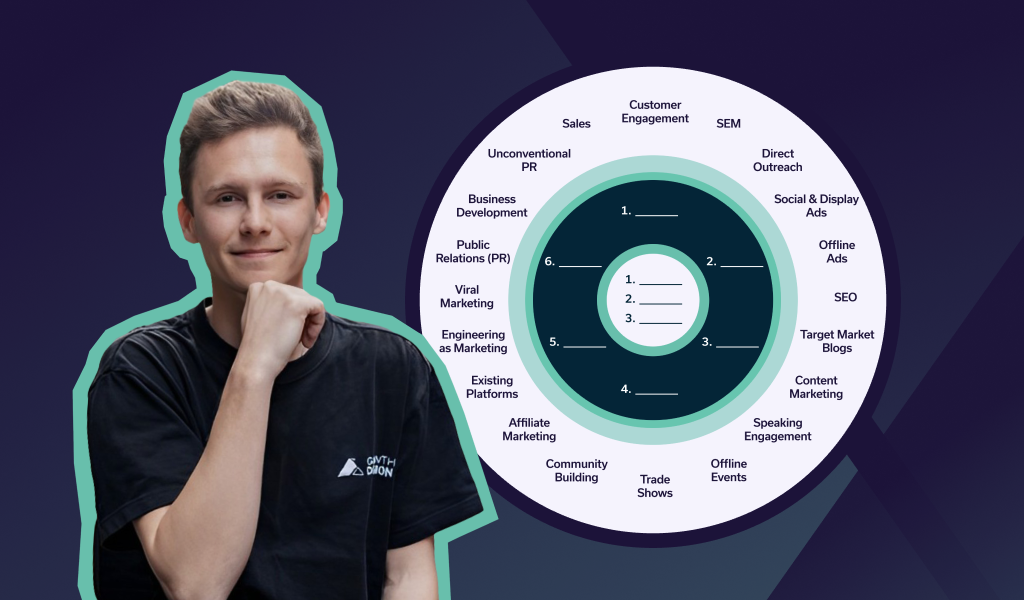What Is A Go-To-Market Strategy?
When introducing a brand new product or business to the market (or a new market), you need a plan. You need to have carefully thought out, prepared and sense-checked approach for reaching your target audience, convincing them of your proposition, and convincing them you're better than the competition. This is your go-to-market strategy.
It should be based on thorough research and careful preparation, and act as a roadmap for the first few months. While there can be in-built flexibility, where possible you should stick to the plan rather than chasing shadows - otherwise you're not being strategic; you're being reactive.
No two go-to-market strategies are the same. There's no one-sized-fits all approach here. But there are fundamentals that all go-to-market strategies include - if you include these fundamentals, you'll be in a good place.
In this article we're going to take a deep dive into the essential elements you'll need to include in your go-to-market strategy if you want to make your product launch a success.
When Do You Need A Go-To-Market Strategy?
There are several different scenarios when you might need a go-to-market strategy:
- Brand new startups. The most obvious case. When you are building a new company, and launching your first product or service to market, you need a thorough GTM strategy which outlines the way you're going to get traction early.
- New product launches. If you're an established business that's launching a new product you need to put together a GTM strategy, which still includes a lot of the same features that a startup's might.
- New geography launches. If you've had success in one country, but you want to launch into another, you'll need to put together a GTM strategy for the new country. We did this with our client Libeo. They had a successful payments tool in France, which we helped them to launch in the UK.
- New sector launches. You may have an established product, but you think it's applicable to a different sector. For example, you build a shift-scheduling tool for the hospitality sector but you think it could be used for healthcare organisations. You would need a GTM strategy to launch into this new sector.
How Do You Write A Go-To-Market Strategy?
Writing a go-to-market strategy takes time and dedication. You'll need to be prepared to forget your assumptions, put aside your ego, and let your research dictate the direction you take.
There are 3 mains steps to writing a go-to-market strategy:
- Research. You need to spend a long time researching the market, competition, laws and regulations, analysis and audience. Fully immerse yourself in the detail and you'll be better equipped to make strategic and tactical decisions.
- Writing. Using the results of your research, you need to structure and write your go-to-market strategy so that it clearly maps out the logic of your thinking and provides a clear, easy-to-follow roadmap.
- Stress-testing. You need to test your GTM strategy before you dive in head first. Practically, this can be as simple as sending it to valued advisors - tell them to approach it as objectively as possible, and to challenge you on everything. If it stands up to scrutiny from commercially-savvy people, you're in a good place.
These are the main stages. But they don't describe the crucial elements you need to include to ensure your go-to-market strategy will be a successful one. That's what we're going to tackle next....
Essential Elements Of A Go-To-Market Strategy That Works
1) Market Understanding
It's essential - absolutely vital - that you leave your ego at the door. Forget what you think you know and be prepared to be wrong in your assumptions. Otherwise, you're likely to fall victim to confirmation bias during your market research phase. You'll pay attention to data and trends that support your hypothesis, and ignore those that don't. If you start out like that you could end up with a completely dysfunctional GTM strategy.
Once you've done that, it's time to start researching. Begin with the competition - what existing products and brands exist in the space. Objectively speaking, what are their strengths and weaknesses? In terms of product, brand and marketing? Why do you think they've made the decisions they've made?
It can be helpful to plot this on a simple matrix. You could do one for product features and one for brand. See our example below:
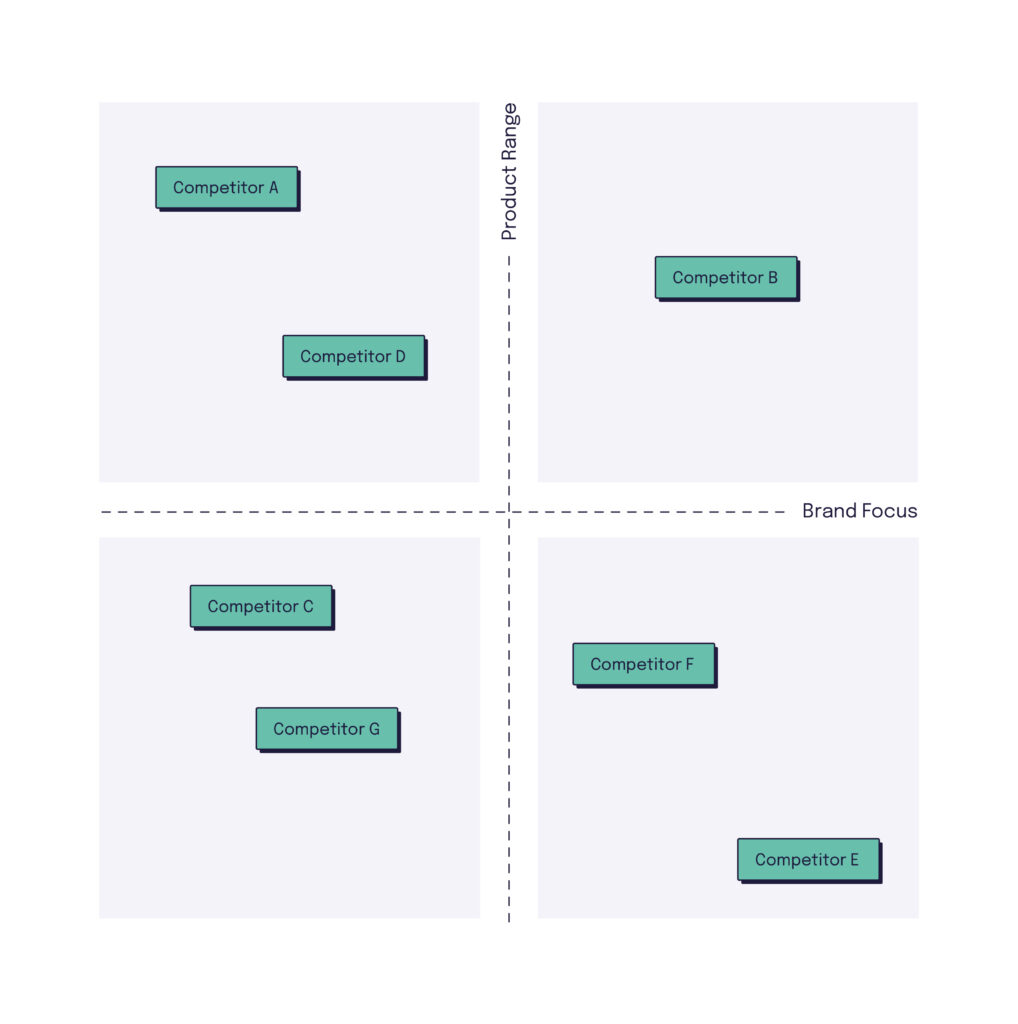
This can give you an easy, visual way to spot where the opportunities are.
As well as research the competition, try to digest as much academic thinking as you can related to your sector. This could be research papers - like those produced by Mintel or Forrester. Whatever you can get hold of, absorb it and arm yourself with the insights you derive.
2) Customer Orientation
It's absolutely vital to become customer oriented when writing your go-to-market strategy. Many founders, marketers and product leaders fall victim of believing that their believes, behaviours and attitudes are reflective of the customer. But the customer almost always thinks differently.
Often, if you've come up with a new product idea, it's because you've come up against a pain point or frustration that you think needs solving. You might therefore assume that others think about the issue the same way. But you're different - you started thinking about solving it - so you therefore AREN'T the same as the customer. If you get sucked into believing the customer thinks the same way as you, you'll come unstuck when you launch.
The best way to become customer oriented is to, simply talk to them.
- Have informal conversations. Talk to people about their interactions with the sector, what they like and don't like, and where they get their information from/how they make purchasing decisions.
- Run qualitative research. If you can, formalise the conversations into a qualitative research project. Talk to 10-20 people who fit your hypothesised target demographic and draw out the key repeating themes.
- Run quantitative research. If you can, or if appropriate (quant research is more commonly used for B2C products) run survey-based research to get firm data on how widespread the themes are. Ask specific, closed questions that force people to choose an answer so you get more useful data. Ask about lifestyle and media consumption, and include demographic/geographic/education/work questions so you can segment the data and build an understanding of what types of people might be the best fit.
Once you've become customer oriented you should have a good, research-supported idea of your customer's needs and how you could address them. You should know, for example:
- What their pain points are
- What sort of language they use to describe those pain points
- What sort of media they consume
- What criteria they use to make purchasing decisions
- How they research products before they buy them
- What social media they use
- Etc etc...
With that knowledge you'll be in a great position to understand what you need to say to potential customers and where you need to say it. You can also, at this stage, start considering how you can build an audience first, using wait lists or similar techniques.
3) Value Proposition & Positioning
Your value proposition and positioning are some of the most important elements of your go-to-market- strategy. They fundamentally how you communicate the benefits of your product, and how you're different from the competition.
There are many different ways to structure a value proposition. We're going to talk through three main methods you can use here.
Method 1: The Three 'C's.
A great tool for coming up with an effective positioning is by thinking about the Three Cs - Customer, Competition & Company.
Customer - think about what you've learned about the customer during your research. What do they most need to hear from you in order to make a purchase? How can you assure them that you understand them, and can help them solve whatever problem they want to solve?
Competition - think about how you can stand out from the competition in a way that still addresses the customer's needs? What positioning do your competitors use and how can you achieve differentiation in the mind of your customer while remaining relevant?
Company - ensure your positioning is actually true to your company's product and behaviours. A value proposition or positioning statement is a promise to a customer - if you break that promise, you won't last.
Method 2: The Mad Libs Breakdown
Have you ever played Mad Libs? Well, oddly enough, a (less fun) version of it can be used to come up with your positioning statement. We use this a lot with our clients in order to help them explain their positioning more clearly. Here's an example:
Our....[product]Helps...[our target audience]Who want to...[audience pain points/goals]By...[product function/truth]and....[additional benefit]Unlike...[the competition]
This is just one example structure. But you can see that it leads you through the same kind of thinking as the Three Cs method. Your insight about your customers, your fundamental benefits and your differentiation from the competition.
Method 3: The Benefit Ladder
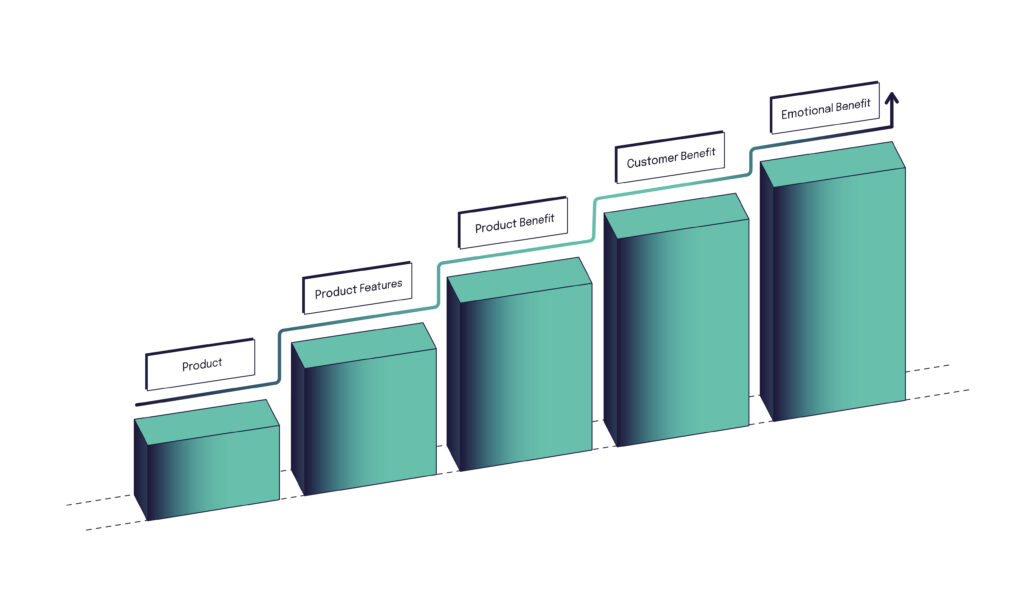
The Benefit Ladder is a way of thinking about your positioning to ensure you are resonating with what your customer fundamentally needs to feel about your business.
It's relevant for both B2C and B2B - because B2B buying decision-makers are still human after all.
The point of the benefit ladder is to help you elevate your positioning above 'product features' and get to the fundamental emotional benefit a customer would have from buying your product. For example, say your business makes an AI that helps financial services companies stay compliant. The benefit ladder could look like this:
Product = AI compliance tool
Product features = Scans trades and swaps to ensure FCA compliance
Product benefit = Financial services companies can be more consistently compliant with regulations
Customer benefit = Compliance teams have less stress, avoid their companies being fined, and improve their job performance
Emotional benefit - Our AI compliance tool gives you much-needed peace of mind.
By climbing the benefit ladder, you arrive at a fundamental benefit that helps you ensure you're communicating to the customer's deepest needs. It will help you with differentiation, creative development and communications effectiveness.
You can use any of these three methods, or combine more than one, or use none at all. But fundamentally, you need to think like this in order to get an effective value proposition and/or positioning. The next step is to decide what channels to market you're going to use to communicate your value prop to the market.
4) Channels To Market
Choosing your initial channels to market can be tricky. You may have a pretty good idea of what channels your customer uses, you may know roughly what sort of costs are associated with each channel, but it's difficult to make a decision on what to start with and how those channels might interact.
There are two methods we're going to discuss here to help you narrow down your options.
Method 1: The Bullseye Framework
The Bullseye Framework, developed by Gabriel Weinberg and Justin Mares, is one method we regularly use at Growth Division with new clients to help them narrow down their options and come up with a resource-efficient selection of channels to test.
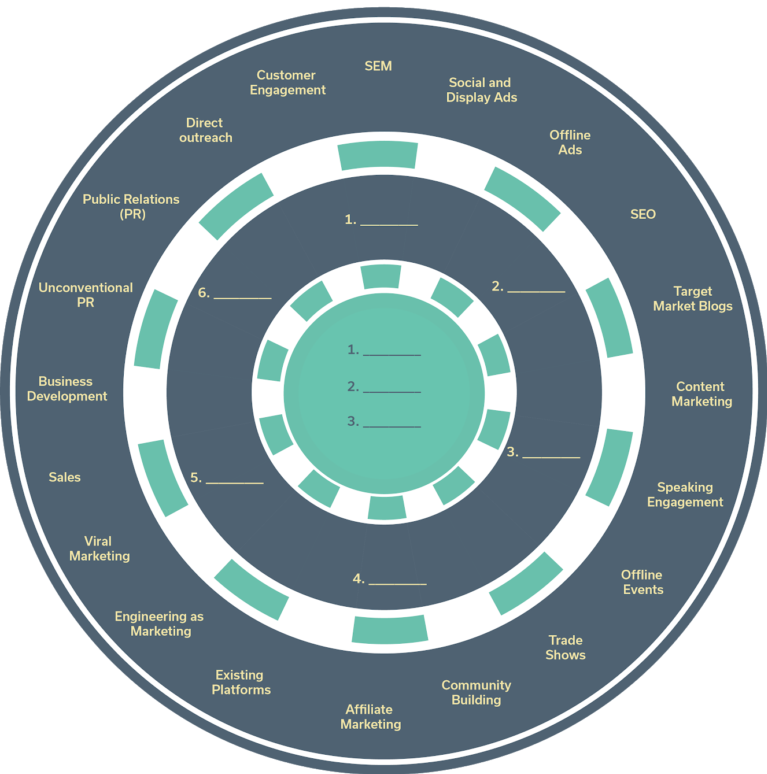
The Bullseye Framework
What we do is we spend an hour, in a free strategy session, talking through each channel in the outer ring of the bullseye and its merits, drawbacks and relevance to the target market. We then create a short list of usually 3-6 channels, depending on the market and client budget, which we suggest testing at the same time.
We then test these channels over a few months, using expert specialists, and then double down on the channels that are most effective.
We've written in more detail about The Bullseye Framework and how to use it here.
Method 2: The Marketing/Sales Funnel
The Bullseye Framework can give you a useful list of viable channels but doesn't tell you an awful lot about how they interact with each other. That's what a funnel visualisation is for.
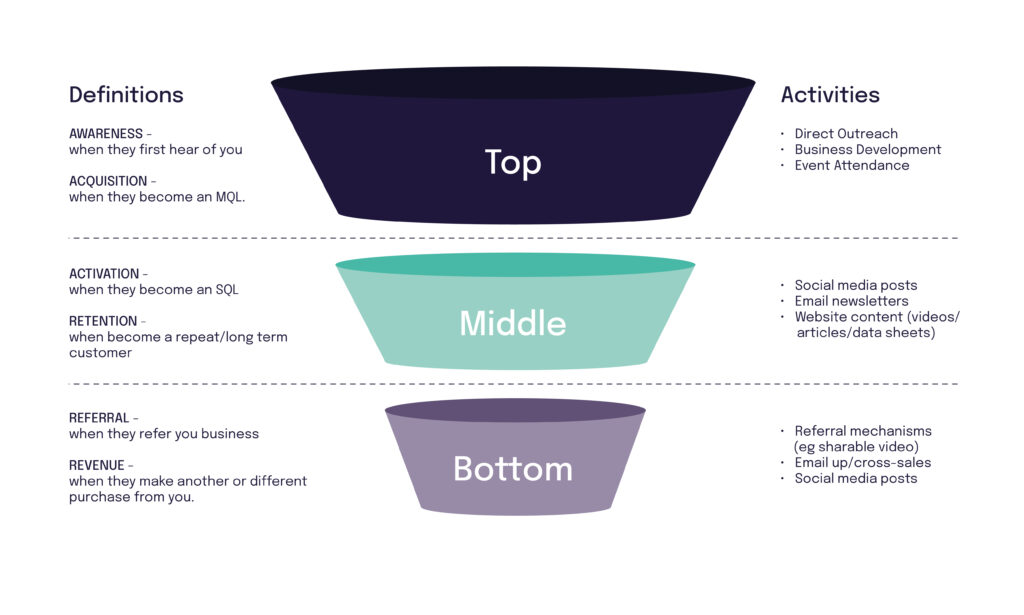
We use the 'pirate' (say AAARRR!) metrics framework to think about marketing and sales funnels at Growth Division. It varies hugely depending on the business and sector but here's an example:
- Awareness – When a customer first discovers your product.
- Acquisition– When a customer becomes a marketable contact
- Activation – When a customer makes a purchase
- Retention – When a customer becomes a repeat/long term customer
- Referral – When a customer refers you to friends/colleagues
- Revenue - When you boost their lifetime value
If you use this framework to consider your channels you'll have a good idea of how they interact with each other, and how important it is to communicate with your customer throughout the funnel. Marketing channels very rarely operate entirely independently and it's important to consider the different touch points a customer will use on their journey with you.
5) Resource & Expertise
The final step of writing an effective go-to-market strategy is planning the resources and expertise you need to execute it. The best strategy in the world won't be worth much if you don't have skilled people doing the actual work.
People
You need to ensure you make full time, free lance or agency hires so that you get the right people executing your plan. If you try to put square pegs in round holes, you make it more likely that you'll fail AND you won't be sure whether you failed due to poor strategy or poor personnel.
At Growth Division our mantra is 'There's an expert for that' and you should adopt this mode of thinking. Get an email marketing expert to execute your email campaigns, and a Meta ads expert for Facebook and Instagram. Find good writers, good data analysists and good strategists.
Tools
You need to ensure you have a martech set-up that makes your marketing as measurable and efficient as possible.
You needs tools for customer relationship management, tracking and analytics, data processing and more. And these tools need to be properly integrated for maximum effectiveness. This will ensure you run a 'smart' go-to-market campaign that will give you the learnings and results you need.
Execution
You need to ensure you have a proper execution approach in place. That means a framework for rigorous experimentation, so that within each channel you are regularly testing hypotheses to find the incremental gains you need. This is the essence of growth marketing - sound strategy, validated with fast-paced and data-led experimentation that constantly looks for ways to make improvements.
You also need to build flexibility into the system. Your go-to-market strategy needs to be solid and broadly followed, but you also need to be able to adapt your thinking to learnings and new data as it comes in. You'll come across challenges that you need to overcome - a key channel you thought would work might fail, or a new competitor may enter the market. You need to be adaptive and light on your feet as well as focused on executing the strategy as best you can.
Talk to a Growth Advisor
We create a clear, focused marketing strategy by combining our expertise with your knowledge of your business.
Trusted by over 130 startups because our unique growth process and team of marketing experts unlock exponential growth








